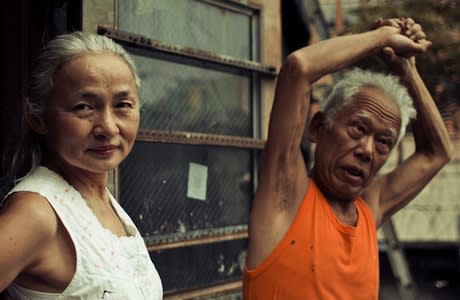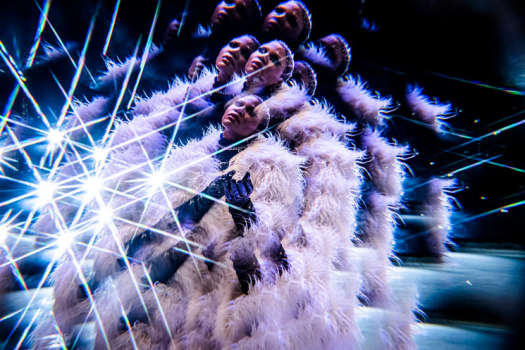Japanese expatriate, Ushio Shinohara, a man with a lifelong dedication to art, was thrust into the spotlight when he arrived in New York City in the late '60s with Neo-Dadaist cardboard sculptures and action paintings—wherein he affixed painted sponges to boxing gloves and punched the blank canvas—in tow. His life, tinged with rampant alcoholism and career fluctuation, is defined here by metaphor. At the age of 80, his life as an artist isn't at all glamorous or financially rewarding, making his act of pugilism as mode of artistic expression has a deeper meaning unto itself.
Zachary Heinzerling's documentary, Cutie and the Boxer, acknowledges the life history and artistic experiences of the "boxer," contrasting present day interviews and footage with old photos, home videos and documentary footage to give an idea of present day as amalgamate of past experiences. But his focus, as the titular suggests, is on his wife Noriko—the "Cutie" component—a woman initially attracted to Ushio's dedication to the craft, so much so that she sacrificed her own ambitions to be a supporting wife and mother.
Her relegation to the role of assistant is something captured remarkably well with Heinzerling's intimate documentation. Noriko is openly resentful at times, discussing the repression of her own art and Ushio's tendency to take her for granted. Her current work, an animation brought awkwardly to life here by digital animation house Artjail, addresses her life more literally than the abstract works of Ushio, capturing the regret and jealousy that seeps into her daily dialogue.
What Cutie and the Boxer is careful to balance, knowing that the narrative trajectory is, in part, making Noriko a martyr, is that amidst the subdued hostilities, even in the face of Ushio dismissing her art behind her back, there is functioning love and mutual respect in this relationship. That the two are divided by twenty years creates more of the core conflict, since Ushio comes from a patriarchal generation where the woman is expected to be subservient.
This makes her balance of validating and sustaining the ego of an artist, indulging his whims—wastefully cooking their remaining food despite persisting budgetary issues on the home front—while trying to control and temper them a tiresome, perpetual reality. In a way, this constant emotional vacillation between frustration and compassion, this give and take in the journey of love, works as a representation of art, which, at its best, works when it references and understands the underlying pain of struggle.
Heinzerling is seemingly trying to construct a narrative about a woman living in the shadow of a man tinged with externally validated greatness. In capturing her feelings with honesty and even humour, he succeeds in defining her as a compelling force unto herself, but where Cutie and the Boxer stumbles is in creating a portrait of a talent emerging from the shadows. Instead, we simply learn what it's like to live within the shadows without any greater expansion on how a light might emerge.
(Mongrel Media)Zachary Heinzerling's documentary, Cutie and the Boxer, acknowledges the life history and artistic experiences of the "boxer," contrasting present day interviews and footage with old photos, home videos and documentary footage to give an idea of present day as amalgamate of past experiences. But his focus, as the titular suggests, is on his wife Noriko—the "Cutie" component—a woman initially attracted to Ushio's dedication to the craft, so much so that she sacrificed her own ambitions to be a supporting wife and mother.
Her relegation to the role of assistant is something captured remarkably well with Heinzerling's intimate documentation. Noriko is openly resentful at times, discussing the repression of her own art and Ushio's tendency to take her for granted. Her current work, an animation brought awkwardly to life here by digital animation house Artjail, addresses her life more literally than the abstract works of Ushio, capturing the regret and jealousy that seeps into her daily dialogue.
What Cutie and the Boxer is careful to balance, knowing that the narrative trajectory is, in part, making Noriko a martyr, is that amidst the subdued hostilities, even in the face of Ushio dismissing her art behind her back, there is functioning love and mutual respect in this relationship. That the two are divided by twenty years creates more of the core conflict, since Ushio comes from a patriarchal generation where the woman is expected to be subservient.
This makes her balance of validating and sustaining the ego of an artist, indulging his whims—wastefully cooking their remaining food despite persisting budgetary issues on the home front—while trying to control and temper them a tiresome, perpetual reality. In a way, this constant emotional vacillation between frustration and compassion, this give and take in the journey of love, works as a representation of art, which, at its best, works when it references and understands the underlying pain of struggle.
Heinzerling is seemingly trying to construct a narrative about a woman living in the shadow of a man tinged with externally validated greatness. In capturing her feelings with honesty and even humour, he succeeds in defining her as a compelling force unto herself, but where Cutie and the Boxer stumbles is in creating a portrait of a talent emerging from the shadows. Instead, we simply learn what it's like to live within the shadows without any greater expansion on how a light might emerge.




